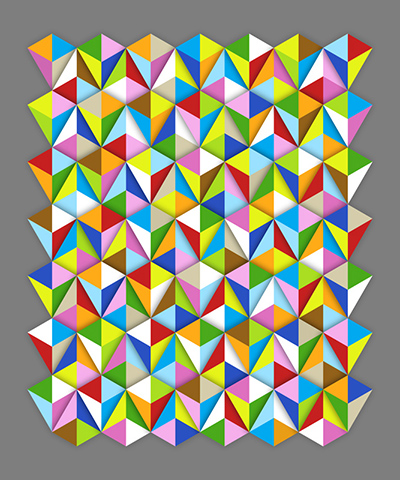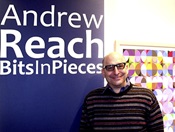Andrew Reach (b.1961)
Ninety-One Kites, 2018
Materials: Archival digital print on cotton rag, edition no. 2/3
Dimensions: 48” x 40”
Location at Summa Health: Dr. Gary B. and Pamela S. Williams Tower on the Akron Campus (141 N. Forge St.), Fifth Floor, hallway outside patient rooms H5-101 and H5-102
About the Art

Andrew Reach’s Ninety-One Kites captivates with its energetic display of color, geometry, and movement. This archival digital print offers an abstract yet dynamic composition, where colorful kites seemingly float in a grid-like structure, each with shifting hues and depths. Reach describes his use of grids as a "liberating but indispensable skeletal backbone," essential to both the structure and expression of his work. Within this framework, he weaves color through geometric forms, offering a visual representation of movement that serves as a personal metaphor for his struggle with physical limitations caused by a debilitating spinal disease.
The title, Ninety-One Kites, refers to the precise arrangement of shapes: 49 upright kites and 42 inverted kites, forming a distinct 7x7 and 7x6 grid. As you observe the work, you may notice how certain colors advance while others recede, creating a sense of depth and rhythm. The artist credits Josef Albers and Anni Albers with influencing his approach to color and pattern, evident in the vibrancy and thoughtful intensity of the work’s palette.
Reach’s journey from architecture to digital art emerged as a way to express motion and energy despite physical constraints. Through digital processes, he found a medium that not only suited his artistic vision but also allowed him to work at the scale he desired. His reflection on digital art’s role in contemporary creative practices continues to shape his work, offering new possibilities where digital and traditional methods converge.
In addition to digital prints, Reach’s recent work has expanded into textiles with geometric patterns, as well as sculptures where digital prints are transferred to rigid materials such as metal and acrylic, shaped into three-dimensional forms with CNC routers.
About the Artist

Originally trained as an architect, Andrew Reach transitioned into digital art following the onset of his spinal disease. He holds Bachelor of Arts degrees in both design (University of Florida) and architecture (Pratt Institute) and has exhibited his work widely in Ohio and across the U.S., including New York, Washington, D.C., Chicago, and Miami. His digital works are held in corporate and private collections and have been featured in both print and online publications. Reach’s public work can also be seen in downtown Cleveland, and his ongoing exploration of the intersection between digital and traditional artistic techniques continues to inform his evolving practice.
Where You Can See More of This Artist’s Work
Reach’s digital art has been widely exhibited in solo, and group shows across the U.S. His work is part of numerous public and private collections. For more on Reach’s work, including exhibitions, publications, and writings on digital art, visit his website.
